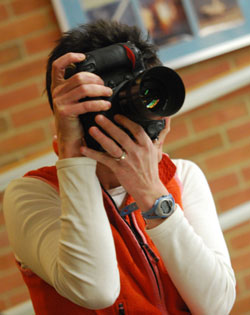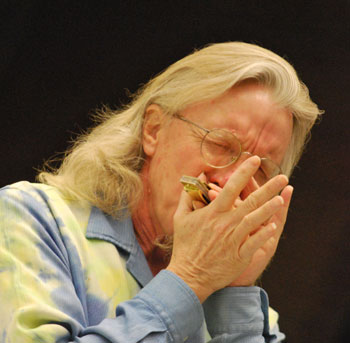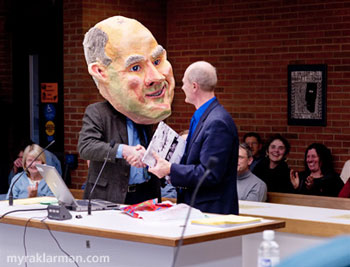“It could snow again,” Says City’s Salt Guy

Mike Bergren, assistant field services manager for the city of Ann Arbor, assures city council that there'll be enough salt on hand, even if it snows again.
City council meeting (March 17, 2009) The “tomfoolery” that the headline indicates is nothing more than a play on words: Tom Wall expressed appreciation on behalf of All Star Hot Dogs; separately, Shoshana Hurand made a presentation about the upcoming FestiFools parade. City council’s Monday meeting also featured a brief performance on harmonica by Peter “Madcat” Ruth and a puppet-head of vast proportions resembling Mayor John Hiefte [photo after the break].
But woven into the mix was less lighthearted fare: People’s Food Co-op Board elections, protection for migratory birds, appointments to a zoning advisory committee, potholes, the vehicle fleet and road salt. Council authorized an expenditure that Mike Bergren, assistant field operations manager with the city of Ann Arbor, said was estimated to get us at least through the rest of the winter – saying it was possible that there’d be ice storms in April.
Road Salt
City council had before it a resolution to approve a $46,560 purchase from Morton International Inc. for road salt. Mike Bergren, assistant field services manager for the city of Ann Arbor, was called to the podium to explain the purchase. [Bergren's name will be familiar to Chronicle readers as the city staffer who called a street sweeper in for clean-up of a concrete spill.] Councilmember Sabra Briere said that she hoped the purchase didn’t mean any more cold weather was expected. Bergren allowed that there could be ice storms through April and it was still March, so the purchase was meant to get the city through the rest of the winter season. If it wasn’t used, it’d be on hand for next year, he said.
Councilmember Leigh Greden said he always had to ask a question about salt, because there’s always reports of other communities running out or paying extra-high prices. From Bergren, Greden elicited the fact that the purchase was being made under the state’s bid participation and they’d gotten a price of $38 per ton. [Editorial aside: Here's an easy real-life math story problem for readers with school-age kids: How many tons of salt did the city purchase?] Bergren said that they were topping off their bid allotment.
Mayor Hieftje noted that last year was the snowiest on record and wanted to know how this most recent winter was stacking up. Bergren said that this winter was ahead of last year’s mark by 23 inches.
This led Hieftje to inquire about potholes: “When can we anticipate potholes getting fixed?” In discussion with Bergren, it emerged that the obstacle to systematic fixing of potholes was that there’s still a lot of groundwater present right now, and that with overnight freezing, the repairs don’t last very long. [cf. pothole section below]
Outcome: Council passed unanimously the resolution to purchase road salt.
Potholes
During communications from council, Greden apologized about the pothole situation that a speaker during public comment time had raised. He stressed that residents could provide essential assistance with the effort of identifying locations of potholes by calling 99-HOLES. He said he’d tested it out and it works. Asked after the meeting for clarification, Greden said that by “works” he meant that he’d called, left a recorded description of a pothole in the area of Stadium Boulevard and Packard, and that it’d subsequently been patched. His attention had been drawn to the pothole when he drove over it.
The public commentary to which Greden had alluded addressed potholes plus other infrastructure issues.
Barbara Bergman [Note that this is not the same Barbara Bergman who serves on the county's board of commissioners.]: The Michigan economy is the worst in country, Bergman said, and the roads are the also the worst. She reported driving down Stadium Boulevard near St. Francis when she hit a pothole filled with water. She said she managed to continue to Trader Joe’s, whereupon she noticed she’d lost her hubcap and bent the wheel. When she went back to retrieve her hubcap, she couldn’t find it among seven other hubcaps.
Her second point was to invite council to imagine what it’s going to be like on the Stadium bridge over State Street on a football Saturday. [The bridge's traffic has been reduced from two lanes each direction to one-lane each direction due to concerns about a beam.] We need to fix both sides of the bridge so that there’s two lanes, she said, and the University of Michigan should help pay for it. Bergman’s third point was that the city of Ann Arbor was contemplating laying off police officers. She contrasted those possible layoffs with the fact that there’s money to pay for a “waterfall in front of city hall” and and $77,000 for a “foreign sculptor” to design it. [The design cost for the stormwater art to be created by Herbert Dreiseitl is $77,000, with the project itself expected to cost around $700,000.] After ticking through the names of around a half dozen art schools in Michigan, Bergman concluded that there could be Michigan artists who are qualified to undertake such a project.
Vehicle Fleet
There were multiple resolutions authorizing the purchase of vehicles for the city’s fleet. Councilmember Margie Teall asked on behalf of a constituent whether bids from local dealerships were solicited. [Dealerships from which the vehicles are to be purchased are in Macomb County, Oakland County, and Lansing]. Answer: The State of Michigan puts out bids and the city of Ann Arbor makes purchases off the state bids – locally, Varsity Ford participates in the bidding process.
Councilmember Sandi Smith elicited a clarification from Sue McCormick, director of public services for the city, about the maintenance records for the vehicles. All maintenance, McCormick said, is now being done by fleet services. Many parts of the ciy’s organization had previously had “mini-fleets,” she said. But the individual departments didn’t depreciate their vehicles, or reserve for their replacement cost. Now, all new purchases are added to the general fleet, she said, which did appropriate depreciation and reserving, and would incrementally result in all city vehicles being a part of the general fleet. But to do it all in one go would be cost-prohibitive, she said.
City administrator Roger Fraser asked McCormick to talk about efforts that had been made to minimize the numbers of vehicles in the fleet. She responded by describing a fleet alternatives analysis that had been undertaken by 25 different staff members on three different work teams: (i) a technical innovation team, (ii) a team that examined type/size appropriateness for the application, and (iii) a team that examined operational policy and uses.
Outcome: The vehicle purchases were approved unanimously.
Migratory Birds
In the introductions section to the meeting, council heard a presentation from the The Washtenaw Audubon Society on the challenges faced by migratory birds at night. Part of that presentation showed how a major path of north-south migration runs over the Ann Arbor region. Navigation at night for such birds is based on cues from the stars and the moon, which leads birds to be confused when they’re confronted with lighted taller buildings. Collisions with glass windows is the factor accounting for the highest mortality rate among migratory birds, around twice that of the second leading cause of death, which is feral cats.
As part of the effort to reduce the hazard from lighted tall buildings, the Safe Passage Great Lakes Days calls for communities to reduce lighting as much as possible March 15 to May 31 and August 15 to October 31 between the hours of 11 p.m. and 6 a.m.
In the brief council deliberations on the subject, Carsten Hohnke pointed out that Ann Arbor had over 50 structures taller than four stories, and that the Safe Passage Great Lakes Days program was thus important to the community.
Hohnke responded to a request from The Chronicle for any compiled information that might have underpinned his remark at the council meeting by providing a tall building inventory. The inventory was mentioned at planning commission’s last meeting, and is not merely a listing of buildings. It gives the height in stories, feet, zoning, floor area ratio (FAR), and tower diagonal for each structure – concepts important for the A2D2 zoning process. [A meeting dedicated exclusively to public commentary on the subject is scheduled for March 23.]
Outcome: Council unanimously passed a resolution supporting Safe Passage Great Lakes Days.
Zoning: Area, Height, Placement
The topic of zoning also arose in the form of the appointment of the AHP (area height and placement) Advisory Committee. Outside of the downtown area, zoning for non-residential properties is also receiving a second look. The committee will begin the process of working with staff to educate the entire community on density, height, and setback in areas outside the downtown. Community services director Jayne Miller sketched out a basic timeline that had the committee working in April, neighborhood meetings in May, community-wide meetings in June, and by the end of the summer a recommendation would be brought back.
AHP Committee
- City Council Representative (1): Marcia Higgins
- Planning Commission Representative (1): Wendy Woods
- Technical Advisory Committee member (1): Kyle Mazurek
- Representatives from each Ward of the City (1 representative per ward)
1st Ward Representative: Michael Hammer
2nd Ward Representative: Jan Newman
3rd Ward Representative: Eric Meaves
4th Ward Representative: Diane Giannola
5th Ward Representative: Marc Rueter - Commercial Association Representatives (3)
Bill Bob Martel
Bill Milliken
Tommy York
Public Commentary
Henry Herskovitz: Herskovitz noted that the day marked the sixth anniversary of the death in Rafah of Rachel Corrie, an American citizen, who on March 16, 2003 was crushed by bulldozer (manufactured in the U.S.) driven by a soldier-driver with the Israeli military. Herskovitz described her death as a “murder.” He said that although the case had been ruled by the Israeli military as an “accident,” the incident had provoked criticism by human rights groups. Herskovitz said that Israel had “celebrated” the anniversary by shooting an American peace activist three days ago: Tristan Anderson, who like Rachel was working with the International Solidarity Movement in Ni’lin, which is in Palestine. Anderson had been hit in the forehead by a high-velocity teargas canister, said Herskovitz, and is now in critical condition.
Herskovitz said that councilmembers might wonder, “What can I as a city councilperson do about this?” The first part of his answer was to look to the city’s human rights commission, and to ask the commission to reinstate their 2003 resolution, which called for an end to U.S. aid to Israel.
The second part of his answer was for councilmembers to support the Boycott Divestment and Sanctions Campaign by becoming members of the People’s Food Co-op, and then voting for him in his candidacy for a seat on the co-op’s board. He said that his campaign for the seat was based on the complete boycott of goods imported from Israel.
Tom Wall: Wall announced that he was there to thank the mayor and councilmembers. [A change to vending regulations had been reconsidered to accommodate Wall's All Star Hot Dog stand, at Pauline and South Main streets, which brings together people with disabilities to work on a hot dog stand that operates on UM football Saturdays to raise funds for families in need.]
Wall had with him from the start of the evening Robby, who works at the hot dog stand. After Wall had begun his remarks, Luke and Andrew arrived, joining Wall at the podium. When Wall spotted them, he stopped mid-sentence and exclaimed: “You guys came!!” Wall explained that Andrew inspects the hot dogs and that Luke is the DJ at the stand. Wall was there to distribute All Star Hot Dog T-shirts. He teased councilmember Mike Anglin, saying, “You might need a small, I don’t know.” When the 3-minute timer beeped, Wall attempted to negotiate with Mayor Hieftje an impromptu speaking slot for Luke. The outcome of that negotiation was that Luke did not get a slot measured in minutes but in words – two of them: Hot. Dog.

Myra shoots the mayor: Photographer Myra Klarman was on hand to take pictures of the presentation of her pictures to Mayor Hieftje ... by a giant puppet sculpted to look like Hieftje (see below).
Elizabeth Elling: Elling said she’d been living in Ann Arbor since 1964, but had never spoken at city council, but wished she had. She was there, she said, to speak on behalf of the Allen Creek Greenway Conservancy. She encouraged councilmembers to learn about and embrace the plans of the conservancy.
She said that even though some councilmembers knew about the conservancy, it’s somewhat of a secret. She cited the benefits of the greenway: a walking, biking, baby-strolling path that provides the opportunity for fewer cars; more space in the floodway and floodplain, which is the best way to accomodate flow of water; and it makes Ann Arbor greener and more liveable.
Richard Derrick: Derrick announced that he was going to describe a few things that made him “grumpy.” He said it was basically vandals that leave the downtown area very late, and walk up Detroit street north and cross the bridge where they live. He said they’d knocked over the green posts that AT&T puts out.
He said they’d smashed one of the glass historic markers. He described how they’d torn off a downspout of the farmers market. He also described problems with graffiti, but said that he appreciated the efforts the council had made with respect to graffiti. [City council recently passed an anti-graffiti ordinance.]
Tom Partridge: For public commentary reserved time, Partridge introduced himself as a Washtenaw County Democrat and a former candidate for city council in Ward 1. He said he was there to speak on the need to overcome what could be viewed as historically-based, socioeconomic-based discrimination in transportation in Ann Arbor, Washtenaw County and southeast Michigan. Partridge said that there was still no non-discriminatory transportation in Ann Arbor. He said that the AATA was led by civil rights attorney David Nacht, who was appointed by Hieftje, who had ties to Mary Sue Coleman through his teaching position with UM. He called on council to pass a resolution to stop the bus fare increases that are scheduled to be implemented.
Partridge also spoke during two public hearings on the rezoning of land parcels, criticizing the millions of dollars spent over the last 20 years that, he said, could have been better spent on affordable housing, transportation, education, health care.
At the end of the meeting during public commentary general time, Partridge returned to the topic of the fare increases that are being proposed by the AATA, saying that he opposed them. [AATA's board will consider a resolution at its March 18 board meeting on the fares.] [events calendar]
Miscellaneous
Liberty Bell Award Nomination: Laura Russello was honored for her nomination as the Washtenaw County Bar Association honors one local non-lawyer with the Liberty Bell award, for outstanding service in one or more of the following areas:
- Promoting a better understanding of our Constitution and Bill of Rights;
- Encouraging greater respect for law and the courts;
- Stimulating a deeper sense of individual responsibility so that citizens recognize their duties as well as their rights;
- Contributing to the effective functioning of our institutions of government; and
- Fostering a better understanding and appreciation of the rule of law.
Russello had appeared at the previous council meeting in her role as executive director of Michigan Peaceworks, asking council to support the Iraqi Water Project with its endorsement.
Kiwanis Club 50th Anniversary: Council passed a resolution in recognition of the golden anniversary of the club, which meets Tuesdays at noon at Weber’s Inn.
FestiFools: Shoshana Hurand introduced a video about the concept of FestiFools (a town-gown collaboration), which will enjoy its third annual edition on April 5 this year.
Hurand stressed that it only lasted an hour (4-5 p.m. on Main Street between Washington and William) so people needed to be there during that time.
One of the Foolish People appeared in council chambers wearing a gigantic puppet head resembling Mayor Hieftje and then presented the mayor with a collection of FestiFools photographs by photographer Myra Klarman.
Klarman was on hand to photograph the mayor receiving her collection of photographs.

Peter "Madcat" Ruth gave council meeting attendees a musical sampling on the occasion of a proclamation in honor of his 60th birthday.
Birthday of Peter “Madcat” Ruth: Council passed a resolution honoring the 60th birthday of Ruth, who is an internationally-acclaimed harmonica player. Ruth has lived in Ann Arbor for 38 years.
In his brief remarks, he said that he’d been encouraged by others to move to bigger cities like New York, but he liked Ann Arbor and it’d been a good place to raise his daughter. He then produced a harmonica and blew forth a few bars, which was met with appreciative applause all around.
Later, during public commentary, Peter Stark, who described himself as an organic farmer, musician, and consultant, described fond memories of playing music with Ruth.
Present: Sabra Briere, Sandi Smith, Stephen Rapundalo, Leigh Greden, Christopher Taylor, Margie Teall, Carsten Hohnke, Mike Anglin, John Hieftje
Absent: Tony Derezinski, Marcia Higgins
Next Council Meeting: Monday, April 6, 2009 at 7 p.m. in council chambers, 2nd floor of the Guy C. Larcom, Jr. Municipal Building, 100 N. Fifth Ave. Note: On Monday, March 23, at 7 p.m. in council chambers, there will be a public comment session held on the single topic of the A2D2 downtown rezoning. [confirm date]




